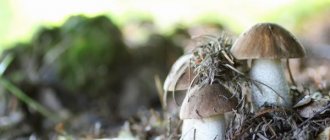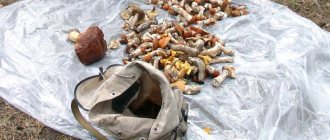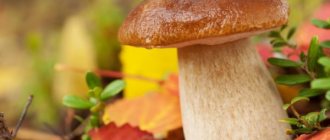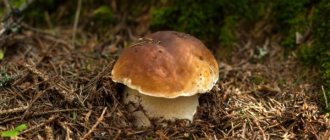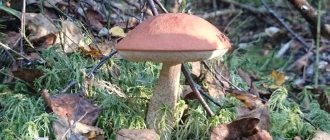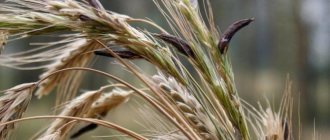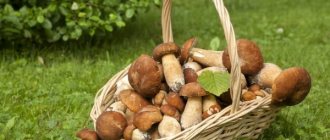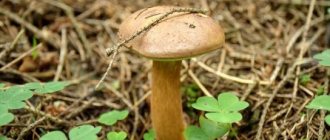Many people are accustomed to considering mushrooms as an autumn forest harvest, but connoisseurs of natural delicacies know that they can begin to be collected in the spring, literally from May. The first mushrooms appear at a time when young grass is barely sprouting, and in terms of taste and healthiness they are not inferior to their autumn counterparts.
The only thing is that collection must be started with caution in order to eliminate the risk of encountering ticks, which are especially active in the spring. It is also important not to confuse edible spring mushrooms with poisonous ones. What mushrooms can be collected in the spring, so as not to wait for autumn?
The earliest edible mushrooms in spring: names, list
In non-black earth conditions, the very first mushrooms appear in April.
The following can survive the last frost and delight you with the first mushroom harvest:
- Morels (lat. Morchella). They form in groups or grow singly: in gardens, parks, forests. Can be found next to aspen, poplar, alder
First mushroom joys
- Skarkoscifa. It looks like a red cup or flower. Due to its unusual appearance, it has many popular names: “elf’s bowl”, “grandmother’s ear”, “scarlet saucer”, “rednushka”, “red petitsa”, “red saucer”. Habitat: mixed forests and park, along the road
Sarcoscypha
- Strobilurus is edible. It has a lamellar structure. Selects spruce and pine forests for fruiting, near pine trees. You can find group and single growths.
Strobilurus esculentus
Safety precautions
Firstly, if a person decides to try the lines, then he should follow all the rules mentioned above. Secondly, if there is even a shred of doubt that everything was done correctly, then it is better to abandon them. In addition, if it is difficult for an inexperienced mushroom picker to distinguish a string from a morel, then you should not collect them yourself. It is not recommended to purchase mushrooms at the market or from strangers. Among them there may be poisonous specimens, and it is not known where they were collected. If the mushrooms grew next to the road or in places with an unfavorable environment, then even morels can be harmful to health.
How quickly do edible mushrooms grow after rain in summer?
Mushroom rain
- Mushroom growth occurs quickly - 1-2 cm per day. The average size of the mushroom is formed in 3-4 days.
- After the rain, harvesting can take a few days.
- It should be remembered that the growth time of the fungus depends on its variety, temperature, air humidity and soil.
- As soon as the growth of the fungus ends, within 24 hours, it begins to collapse.
Active formation of fungal spores begins in warm weather, during the formation of fog, after rain.
Eg,
- Boletus, chanterelle, and honey fungus appear 9-10 hours after the last raindrop fell. It is better to collect them within 8-10 days after their appearance.
- Morels and strings decompose after a week.
- Camelina, milk mushrooms, and oyster mushrooms are well preserved for almost 2 weeks.
- Varieties of porcini mushroom , after passing five days after the onset of favorable conditions, grow 9 cm above the ground. During this time, his weight increases to 40 grams per day. The maximum period for collecting it is 10-12 days.
- Mushrooms growing in autumn form much more slowly, some of them can only be collected after 4-5 days.
Conical morel
The height of the cap is up to 6 cm, thickness up to 5 cm. Externally, it is conical, sometimes ovoid, its edges grow together with the stem. The inside of the cap is hollow; there are elongated cells on the surface. Its color is dark brown or gray-yellow-brown. The length of the leg is up to 5 cm, its thickness is up to 2 cm. Cylindrical, hollow, painted white or slightly yellowish. Its pulp is thin, brittle, waxy.
What edible mushrooms appear in spring in May: photo list, names
May is not rich in harvest. This is the period when natural gifts are just gaining strength for the summer and generous season.
But, if you wish, you can find pioneer mushrooms in the deep forest.
- The dog is orange. Orange mushrooms are small in size. People call them “saucers”. They grow on soil. You can find them along the forest path and at the forest edge. They grow well in fire pits.
Peziza aurantia
- Lines. They have a tortuous cap and a thick gray stem. They choose rotting stumps and branches and deciduous trees for growth.
Gyromitra esculenta
- Morels of various types continue to bear fruit more actively after the first April harvest .
Ordinary
Conical
Stepnoy cap
- Discina thyroid. The mushroom calyx is brown or pink in color and slightly wrinkled in the center. Prefers forest, park and garden moist soil.
Discina ancilis
- Borovik. The cap is brown or brown. Loves dry and light pine, oak, and hornbeam forests.
Boletus pinophilus
- Kalotsibe. It has a dense and beautiful cap of white or yellowish color. Can be found in the garden, lawn, and deciduous forests.
Calocybe
- Honey fungus. It has a smaller cap than other types of honey mushrooms. In a young mushroom it is bell-shaped; as it matures, it evens out, leaving only a small tubercle in the middle. Painted light brown. Grows in bunches.
Marasmius oredes
- Field champignon. The “cap” is white, spherical or open in shape. Found on lawns or along roads.
Agaricus arvensis
- Roseplated thyroid . People call it Podabrykosovik. It has not thick plates. Grows in forest areas.
Entoloma sinuatum
- Raincoat. The mushroom is shaped like a pear. Painted grey. Habitat: birch and pine plantations.
Lycoperdaceae
- White dung beetle (conditionally edible) . The color is brownish-red, white, gray or orange. They prefer to grow in groups on land well fertilized with manure.
Coprinus comatus
- Oyster mushrooms . Painted brown or gray. The head is dense. Most of the growth occurs in deciduous forests.
Pleurotus
- Deer mushroom. Small convex caps of gimlet-gray or gray color in a young mushroom, with growth they turn into a flat cap with a convex center. Most often, rotten wood is chosen for propagation.
Pluteus cervinus
- May mushroom . Usually collected on St. George's Day. Young mushrooms are hemispherical or round in shape. As they grow, the edges become wavy and curve toward the sky. Color: yellowish-white. It grows in large groups in open forests, grassy parks, gardens, and along the edges.
Calocybe gambosa
Important: Early varieties of mushrooms that appear in the spring are divided into two key types:
- The first ones are to be collected only in spring
- The second - the first harvest is harvested during the spring thaw, then grows throughout the summer, and some in the fall
Roseoplate thyroid
mushroom
also has another name - podabrikosovik, because it grows in the southern regions of Russia, and likes to settle in places inhabited by humans, under fruit trees - pears, apricots, and so on.
The mushroom is brown in color, its size is usually small - within 10 cm. While the mushroom is young, its cap has a conical shape with a blunt end, but then it opens, but its edges remain curved. The leg can reach 12 cm in height. These mushrooms are rarely eaten boiled or fried, but are usually canned to create a delicious, flavorful snack.
Interesting: Why are chanterelles not wormy? Reasons, photos and videos
What edible mushrooms appear in the summer at the beginning and end of June: photos, list, names
Experienced mushroom pickers are looking forward to the June mushroom season. This is an amazing opportunity to stock up on your favorite gifts of nature without waiting for the abundant autumn harvest.
It is in this summer month, if there is appropriate weather with fog and rain, that the first surge of the mushroom layer occurs.
Appears:
- Common boletus
Suillus luteus
- Sulfur-yellow tinder fungus (conditionally edible)
Laetiporus sulphureus
- boletus
Leccinum
- Boletus
Redhead
- Green moss mushrooms
Xerocomus subtomentosus
- Wood-loving collibia
Collybia dryophila
Continues to grow abundantly:
- Meadow honey fungus
Lamellar type of mushrooms
- Champignon
Agaricus
- Occasionally there are pigs
Paxillus involutus
By the end of the month the following begin to appear:
- Firstborn foxes
Cantharellus cibarius
- Valui
Russula foetens
- Russula
Russula
- Loadings
Russula
- White mushrooms
Birch bearweed, Boletus edulis
- The main mushroom backbone in June is the summer honey fungus
Kuehneromyces mutabilis
Row May Calocybe Gambosa
Follow the link to read more about the May row
Row May Calocybe Gambosa
Carefully! Among the early spring mushrooms, many are conditionally edible, but there are also poisonous ones, for example:
Spring Entoloma Entoloma vernum - grows from April to June in broad-leaved, less often coniferous, forests. It looks inconspicuous, but it can accidentally end up in the basket.
Spring Entoloma Entoloma vernum
What edible mushrooms appear in the summer at the beginning and end of July: photos, list, names
The July heat is not conducive to good mushroom growth.
There is no abundant harvest this month. Occasionally, if there is rainy weather, you can look for:
- boletus
- boletus
- boletus
- russula
- chanterelles
- waves
- other mushrooms that appeared earlier
Opens its season - only milk mushrooms
Lactarius
boletus
This mushroom can be found in May under favorable weather conditions. It is popularly called birch and blackhead. You can meet it in a light deciduous or mixed forest where there are birch trees.
You can collect boletus mushrooms from the end of May. The signal for the appearance of such mushrooms is the flowering of bird cherry.
The mushroom is spongy. Its cap can reach a diameter of 15 cm. Depending on the type of mushroom, its color can be from white to dark gray, close to a black tint. The color darkens as it matures. If the air is humid, mucus appears on the cap and it becomes sticky to the touch.
The leg is white, slightly thickened at the bottom. There are longitudinal scales of white or black color. The stem has a cylindrical shape, can reach 15 cm in height and up to 3 cm in thickness. In old mushrooms, the pulp of the stem becomes hard and fibrous.
The pulp is white in color, which does not change when cut. If the area is swampy, then the mushroom may have pinkish flesh at the break. This type of boletus is called pinkish boletus. In mature mushrooms, the pulp becomes watery and loose.
Boletus mushrooms can be prepared in different ways. Mushrooms are suitable for drying, frying, boiling and pickling.
What edible mushrooms appear in the summer at the beginning and end of August: photos, list, names
With the onset of August, fogs begin and dew falls abundantly. These are excellent conditions for the development of fungi.
A huge number of nature's favorite gifts appear in the forest.
- Rizhiki - the royal mushroom
Belongs to the species Lactarius
- Autumn mushrooms are real
Armillaria mellea
- Polish mushrooms - panskie
Boletus badius
Begins to bear fruit abundantly:
- various specimens of milk mushrooms
- boletus
- greenfinch
- White mushroom
- boletus
- boletus
- chanterelles
- russula
- waves
- different types of moss
About 120 species of various edible mushrooms grow during this period in various areas of the natural environment.
Be careful when going for mushrooms. Edible mushrooms have a lot of toadstool counterparts. Collect mushrooms that you are 100% sure are edible.
- Mushroom dishes are very tasty and healthy
- They are a true decoration of any holiday table.
- If prepared correctly, they can be stored for a long time.
Free information
Are morels poisonous?
These spring mushrooms, photos of which can be seen in this article, do not contain toxic substances. These are quite valuable gifts from the forest, in great demand in the West. For example, in the USA they are considered one of the best. In the States, morels stand out from other mushrooms because of their cost, which often exceeds $150 per 1 kg. So there is no need to be afraid of them - these spring mushrooms are edible.
Considering that morels can be confused with strings (we’ll talk about them below), it’s worth heat treating them before eating them. Boil them for 15-20 minutes, then change the water and repeat the process. Then they need to be washed with cold water, and then fried or boiled without fear for your health. All poisonous toxins pass from the mushroom into water when boiled.
False honey agaric
The poisonous false honey fungus, unlike its fellows, has rested in the winter and is now trying to confuse beginners when picking mushrooms. After all, not everyone knows that in the spring months only inedible honey mushrooms, which are life-threatening, sprout, while good fruits appear only in the summer.
It’s not difficult to identify a false honey fungus! The gray-yellow color makes the honey mushroom family stand out from the majority. From mid-spring to late autumn they germinate wherever there is fertile soil, logs and rotten stumps.
Bluefoot
One of the most favorite mushrooms among many lovers of quiet hunting is the blue leg. Its main feature is a blue-lilac thickened leg, a light hat and a lattice-like surface under it.
Beneficial features
Hedgehog is an extraordinary mushroom that helps to cope with many problems:
- has antibacterial properties, provides protection against E. coli, staphylococci, its juice can be used to treat a cut wound;
- allows you to quickly build muscle mass when consumed during intense training;
- tones, adds strength and energy;
- relieves depression;
- improves sleep;
- removes toxins;
- improves lung function, increases lung volume;
- nourishes the body with useful substances - thanks to it, hair and nails become stronger and begin to grow faster;
- improves blood quality and accelerates its circulation.
Did you know? Chinese researchers believe that, in terms of its medicinal properties, the coral barnacle is practically in no way inferior to another medicinal species of the barnacle, the combed barnacle.
Spring joy of a mushroom picker
At the end of April, when the snow melts, the time for early spring edible mushrooms begins. At the beginning of May there are many days off; visiting the forest awakening from winter at this time is a pleasure; you don’t have to deny yourself this. You can breathe freely and easily in the forest, you can feel the cold coming from the snowy hollows, the sky is clear and cloudless, it’s time to look for edible mushrooms, although the season is still far away. Experienced mushroom pickers train on the first spring mushrooms long before the onset of the main abundant mushroom season.
In terms of fame and popularity, the first are mushrooms called morels. In Europe and our country, these mushrooms have been known and popular as edible since the 16th century. A detailed description of these mushrooms can also be found in Russian herbalists. Many people do not consider these mushrooms to be an edible product. But this is a completely safe product, it is very tasty, has been used in cooking for a long time, the population of the planet is still wary of it, many recommend not eating much, draining the water several times during cooking to remove harmful toxins, they believe that indigestion is possible .
Edible morels are very different, edible or ordinary morel, also conical, round morel, morel cap. Morels appear as soon as the snow cover melts, clearings warm up after winter when the first shoots of ferns emerge, mushrooms are found on steep river banks, in alder thickets, on the slopes of ravines, among willow trees and bushes. Morels are also found in gardens where plum and apple trees grow, where the soil is rich in nutrients and humus due to falling fruits and leaves. The caps of morels are elongated, conical, and hollow. The mushroom stem is light, from brown to beige, the cap is noticeably darker.
The second type of spring mushrooms are string mushrooms; giant and common string mushrooms grow in our forests. When the snow has not yet completely melted, much earlier than morels, lines appear first in pine and mixed forests, in fires and old clearings, on the slopes of ravines, along river banks. The mushroom is very interesting in appearance; the cap looks like a walnut. The giant stitch is similar to the regular stitch, but is larger in size. His hat is lighter in color compared to the morel. The strings are eaten with caution; they are boiled, draining the water several times.
The first spring mushrooms are considered a delicacy and delight mushroom pickers with an unforgettable aroma and taste.
Sarcoscipha scarlet
Some representatives of the mushroom kingdom delight mushroom pickers only in the fall, others appear in early spring, as soon as the snow melts, and in some areas - already at the end of winter. The snow is still white all around, and scarlet Sarcoscipha is already blooming on the fallen branches, looking more like fancy flowers than mushrooms.
Sarcoscipha scarlet
Sarcoscypha scarlet - lat.Sarcoscypha coccinea
This saprophyte is otherwise called Petsitsa red, Grandmother's ear, Sarcoscipha bright red, Scarlet elven cup, Sarcoscipha cinnabar red or Sarcoscipha Austrian.
Description of the mushroom
hat
This saprophyte is not large in size and has a cap reaching only 10-50 mm in diameter. The scarlet elven bowl is painted a rich red color both outside and inside. The coloring of the surface of the hats contrasts favorably with the white edges wrapped inside, turning the mushroom into an amazingly beautiful creature.
The cap, filled with tight red pulp, grows in the shape of a glass or cup for wine. If you touch it, you feel a soft fleecy surface. Colorless or pale pink smooth spores in the shape of an ellipse ripen in the cups.
Leg
The whitish legs of Sarcoscypha cinnabar-red grow no more than 30 mm in height and 6 mm in thickness. They narrow towards the base.
The leg does not catch the eye, as it is hidden in a layer of substrate.
Places of growth
Sarcoscipha scarlet chooses dry branches, tree roots and dead wood for growth, covered with fertile soil or fallen leaves. They can settle on woody remains covered with moss. Prefers wood from oak, linden, maple, birch and willow trees.
Grandmother's ear is collected in regions with a temperate climate. It is found on the Eurasian, African, Australian and American continents.
Mushrooms bear fruit in groups and appear at the end of February or March - April, when it is still very cool, and complete fruiting by the end of May. In the case of warm autumn and winter, the mushroom produces an additional harvest.
It is noteworthy that bright red Sarcoscipha does not grow near industrial zones and highways, so the area where it clings to woody debris with bright mushrooms can be considered environmentally friendly.
Sarcoscypha scarlet - lat.Sarcoscypha coccinea
Edibility
Some specimens of Sarcoscipha smell and have no taste, while others exude a light, pleasant mushroom smell. However, it is classified as an edible mushroom. But this fungus is not for everybody: it has very hard flesh, which, after boiling, resembles chicken cartilage.
Cooked Austrian Sarcoscifa tastes good and is just as beautiful as raw, and therefore it is readily stewed, fried, pickled and added to fresh salads, after boiling for 20 minutes. in salted water. The main thing is to have patience when cleaning mushrooms: clearing them of debris is not so easy.
Similar species
Saprophyte resembles the following edible counterparts:
- Sarcoscypha occidentalis. It is distinguished by its elongated light legs and habitat: its homeland is Central America and the USA. The mushroom bears fruit in July–August.
- Sarcoscifa austria. Its caps are more spread out, and their edges often crack. This mushroom grows mainly in the forests of European regions of Russia.
- Sarcoscifa Dudley. Grows exclusively in the USA.
Sarkoscifa
Sarcoscifa scarlet is not only edible, but also medicinal: its components accelerate blood clotting and have anti-inflammatory properties. Mushroom powder is sprinkled on wounds during bleeding to stop the bleeding and prevent infection. North American Indians, knowing about the antiseptic qualities of the mushroom, even sprinkled it on the navels of newborn children after cutting the umbilical cord.
Where to collect
Common morels, as well as such varieties of this mushroom as round, conical and capped morels, are found almost everywhere in the territory of Moscow and neighboring regions. The fruiting bodies of these mushrooms are quite fragile, so they should be collected with extreme caution.
Many of the earliest edible mushrooms appear in large groups on old and rotten stumps or dead wood of deciduous and coniferous wood.
Meadow or field honey mushrooms easily tolerate spring cold at night and prefer rotting deciduous wood, dead wood and rotting chips, stumps and the soil near them. Large groups of edible honey mushrooms can be found in spring in deciduous and mixed forest zones; somewhat less often they grow in coniferous forests, as well as in gardens or parks.
Strange sarcosome
Mushrooms in the form of bowls (sarcoscypha, pesitsa) are often found in spring, but a mushroom in the form of a closed pot was seen only once. Sarcosoma globosum is not particularly edible, but rather medicinal. Although there is information that young mushrooms are delicious stewed with potatoes, and the dish is called sarcosomnic. This is apparently in those places where there is a lot of it.
The mushroom is a container with a transparent gelatinous liquid, closed on top by a leathery disk on which spores develop. The fruiting body together with its contents can weigh 300 grams. People call the sarcosome liquid “earth oil” and use it in a wide variety of ways:
- for rejuvenation - rubbed into the skin;
- to enhance mental activity - take fresh liquid on an empty stomach;
- to enhance hair growth - rub into the scalp;
- for joint diseases - rub into the sore spot;
- as a biostimulant - also fresh liquid on an empty stomach.
Sarcosome also has a general strengthening, calming effect and is used in the fight against cancer. It’s a shame that I only got one mushroom!
Sarcosoma prefers coniferous forests to grow and cleverly hides in moss and coniferous litter; finding it is not so easy. Young mushrooms are smooth brown balls with caps. With age, the mushrooms become more and more wrinkled until they completely dry out, turning into a crumpled plate.
It is problematic to confuse sarcosome with other mushrooms: the liquid and the upper cap are the most striking distinctive features.
Sarcosoma globosum. Sergey TashebskySergey Tashebsky
Romantic sarcoscifa
Now my dog and I are walking through the forest in the foothills of the Caucasus, in the vicinity of Goryachiy Klyuch. There is a forest behind our house, so part of the property has both garden and undergrowth vegetation. It was there at the end of February, not far from the flowering cyclamen, that remarkably bright red “cups” began to appear. Among the first green leaves in the fallen leaves they look very touching.
Scarlet Sarcoscypha coccinea, or Scarlet Elf Cup (what a fittingly poetic name for a mushroom the size of a two-ruble coin!). An edible mushroom that grows exclusively in environmentally friendly places (a balm for the soul of the owner of the site). Very similar to the Austrian elven bowl, but it grows further north.
One or the other species, or even both at once, are found in early spring almost throughout the country. As a rule, specialists see the difference between species; ordinary mushroom pickers do not pay attention to the shape of the hairs on the outer surface. Moreover, you can only see them under a magnifying glass.
Actually, these mushrooms grow up to 7 cm, but I haven’t come across any like them. And although they are edible, their structure is rubbery and gristly and there is no special taste. It should be stewed in sour cream or baked with cheese.
But this mushroom has wonderful decorative qualities. In Europe, in early spring, small gift baskets with green moss and sarcoscyphae are made. A successful alternative to flowers that are no longer in short supply. It is impossible to confuse Sarcoscypha with other mushrooms.
Scarlet Sarcoscypha, or Scarlet Elf Cup (Sarcoscypha coccinea). Claude-Alain Berdoz




